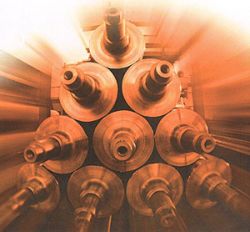 Rollmac designs and manufactures engraved rollers bound to multiple apllications and requests. Besides the traditional rollers (positive or negative raster rollers), special rollers with engravings to coat points (type V) and helicoidal engravings (type G - protected by an international patent).
Rollmac designs and manufactures engraved rollers bound to multiple apllications and requests. Besides the traditional rollers (positive or negative raster rollers), special rollers with engravings to coat points (type V) and helicoidal engravings (type G - protected by an international patent).Cross pyramidal REVERSE rollers
The patented cross pyramidal rollers for REVERSE rotation have been used for many years in the roller finishing machines. They are particularly indicated for the finishing of stiff leather.
With their mechanical action, they are ideal for hot and cold fat liquoring and for coating printed splits.
"G" type REVERSE rollers with helical engraving
The patented "G" type REVERSE rollers are particularly indicated for the finishing of soft skins, usually harder to feed in, and to create smooth and polished surfaces.
The rollers installed in the new models of the Rollmac machines, using the particular structure of the transport belt, allow to obtain exeptional results in the finishing:
- Easier feeding of thin and soft skins.
- Complete desappearence of the light marks left by the engraving on the surface of the finished skin.
- Better speading of the chemicals creating a mirror-like surface.
- Complete desappearance of the uneven shadows caused by the adhesion of the edge of the skin with the roller, very frequent when finishing smooth skins with viscous products.
- Wider range of capacity when varing the chemicals' viscosity.
Negative pyramidal rollers for SYNCHRO rotation
These rollers are called 'SYNCHRO' because they rotate with a speed synchronized to the skin feeding one.
These are rollers that used to be employed in the direct traditional finishing (SYNCHRO) when softer skins could not be finished in REVERSE.
Normally the skins (especially the soft ones) stick to the roller and need to be removed manually or with a special skin removing machine.
Nowadays the finest incisions are employed to obtain double tone effects (tipping on embossed surfaces); the bigger incisions for the use of dye on soft goat-sheep skins.







